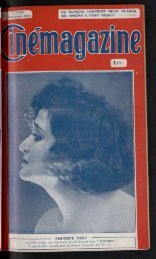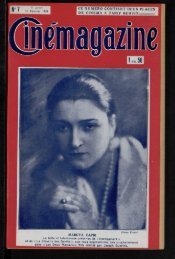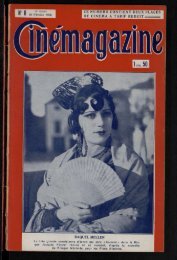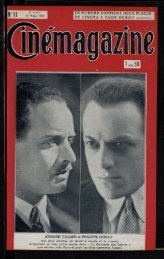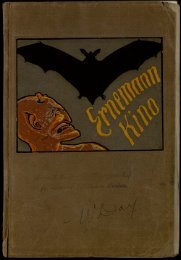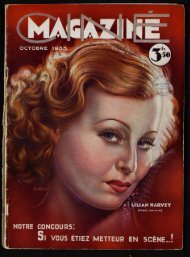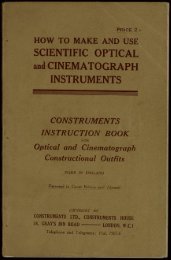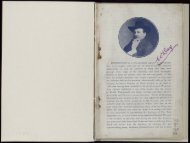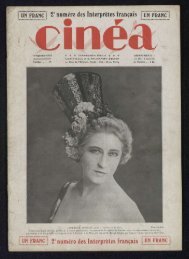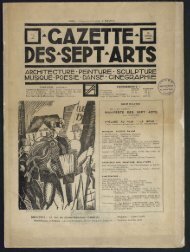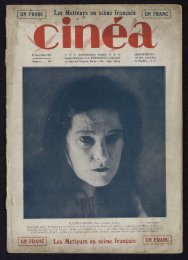Untitled
Untitled
Untitled
You also want an ePaper? Increase the reach of your titles
YUMPU automatically turns print PDFs into web optimized ePapers that Google loves.
88 MODERN MAGIC LANTERNS.<br />
appertaining to a lantern by some long Greek name, are often<br />
called Aphengescopes. It is a useful device occasionally for<br />
demonstration purposes, but owing to the very great loss<br />
of light, can only be employed with limelight or with the<br />
electric arc, and then is never very satisfactory. In Fig. 65<br />
the source of light is shown at B, and the condensers at<br />
c c, the object, which is placed at n, having its imago<br />
focussed upon the screen by means of the objective, E.<br />
There is no need to get a special lantern for the purpose,<br />
as a box is easily arranged to carry the objective at one end<br />
and to receive the nozzle of the lantern in the direction<br />
shown. Such a box should have its interior lined with black<br />
paper, or better, with black velvet. The back can be arranged<br />
to carry the objects it is desired to exhibit, access<br />
being obtained by the side A, which is closed with a curtain.<br />
When the Aphengescope is being used, and, indeed, in a<br />
large number of other cases, it will be found that, unless<br />
steps are taken to prevent it, harm will very frequently occur<br />
from delicate instruments or inflammable substances being<br />
exposed to the intense heat concentrated upon them by the<br />
condenser. To obviate this, what is known as an alum cell<br />
is employed. This is an arrangement similar to that shown<br />
in Fig. 61; in fact, the same cell can be employed for<br />
either purpose, as required. It is filled with a cold saturated<br />
solution of alum, which must have been carefully filtered so<br />
as to be quite free from dust or other floating particles. The<br />
solution will in course of time get fairly hot, but while allowing<br />
nearly all the light to pass, it will absorb the heat, which<br />
would otherwise be doing harm. In the absence of the alum<br />
solution, plain water can be employed. It is not quite so<br />
efficient, but is satisfactory enough for most purposes.<br />
Another arrangement of the lantern for demonstration<br />
purposes is that shown in Fig. 66, which shows the method<br />
of making vertical projections, as they are called. The<br />
beam of light from A, as it leaves the condenser, B, falls<br />
upon a mirror, F F, placed at an angle of 45 degrees<br />
with the horizontal, from which it is reflected vertically<br />
upwards. The table, n D, upon which the object to be<br />
projected is placed, is immediately over the mirror, while<br />
above it is placed the objective, E, bearing above it again a<br />
LANTERN EXPERIMENTS.<br />
reflector, G, which once more directs the beam in a horizontal<br />
direction to the screen. For most purposes such<br />
an arrangement can be fixed up at very little expense to<br />
answer all requirements except where great brilliancy and<br />
crispness of definition is desired. The bottom mirror can be<br />
a piece of the usual silvered plate glass, the top one is best<br />
of the thinnest silvered glass procurable, as if not, the<br />
Fig. 66.<br />
ARRANGEMENT OF LANTERN FOR VERTICAL PROTECTIONS.<br />
secondary reflection, that from the surface of the glass itself,<br />
may become troublesome. It will be seen that the two<br />
component lenses of the condenser have to be separated, one<br />
remaining in the usual position in front of the illuminant,<br />
and the other immediately beneath the table carrying the object<br />
to be projected. With this arrangement of the apparatus<br />
many experiments, such as those showing crystallisation,<br />
etc., can be performed. For this purpose a glass dish with<br />
an even flat bottom is required. This is placed upon the<br />
89



